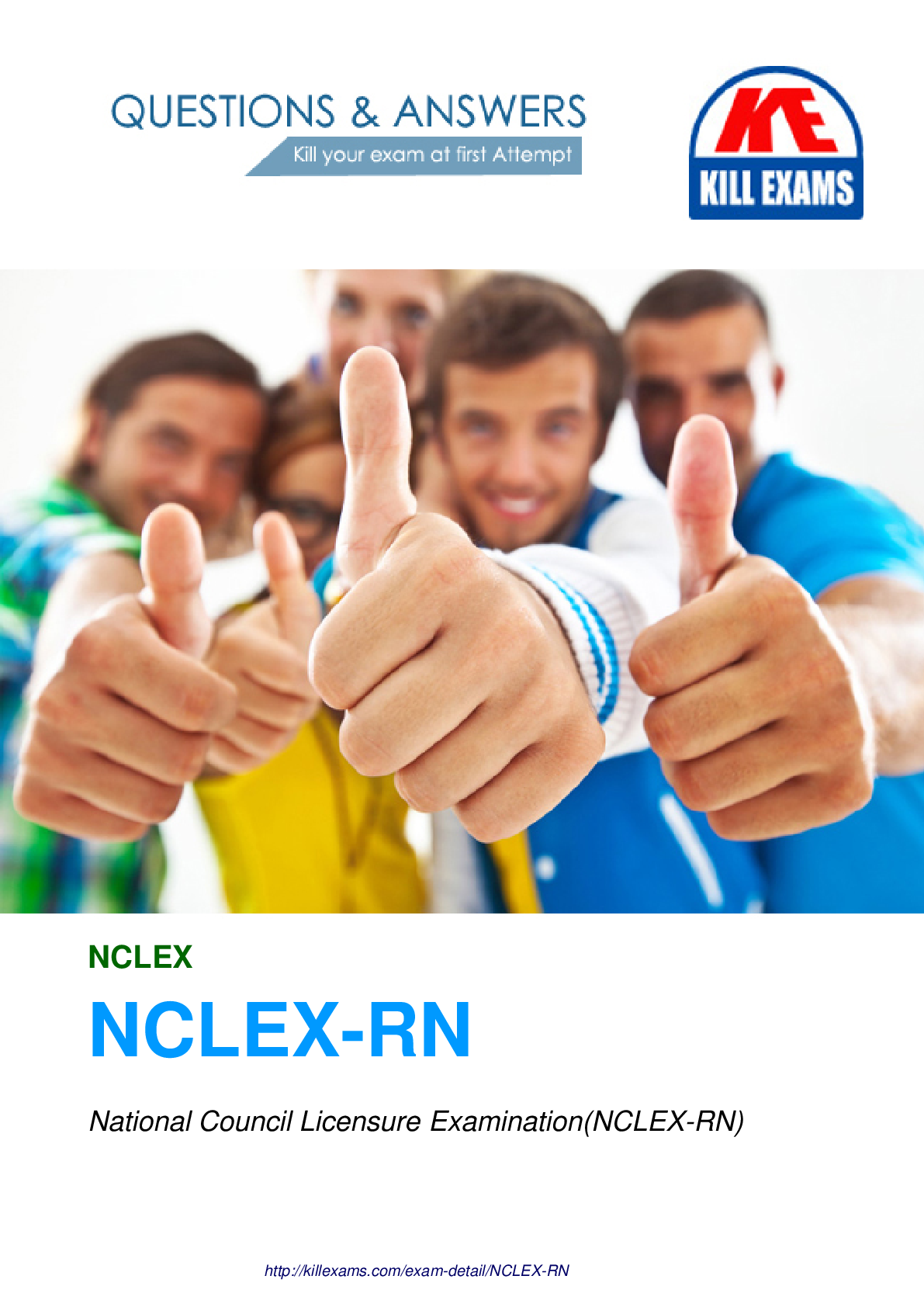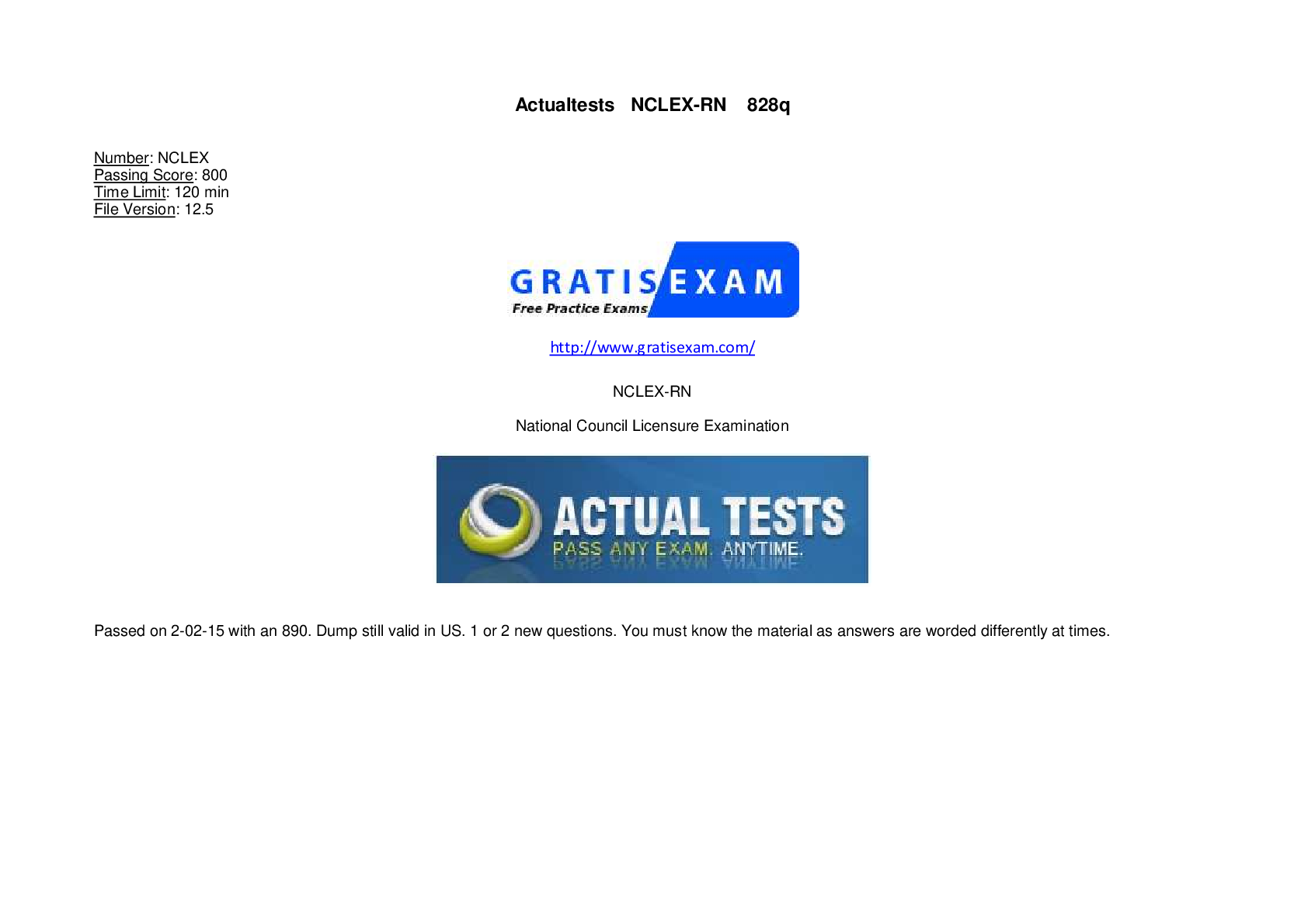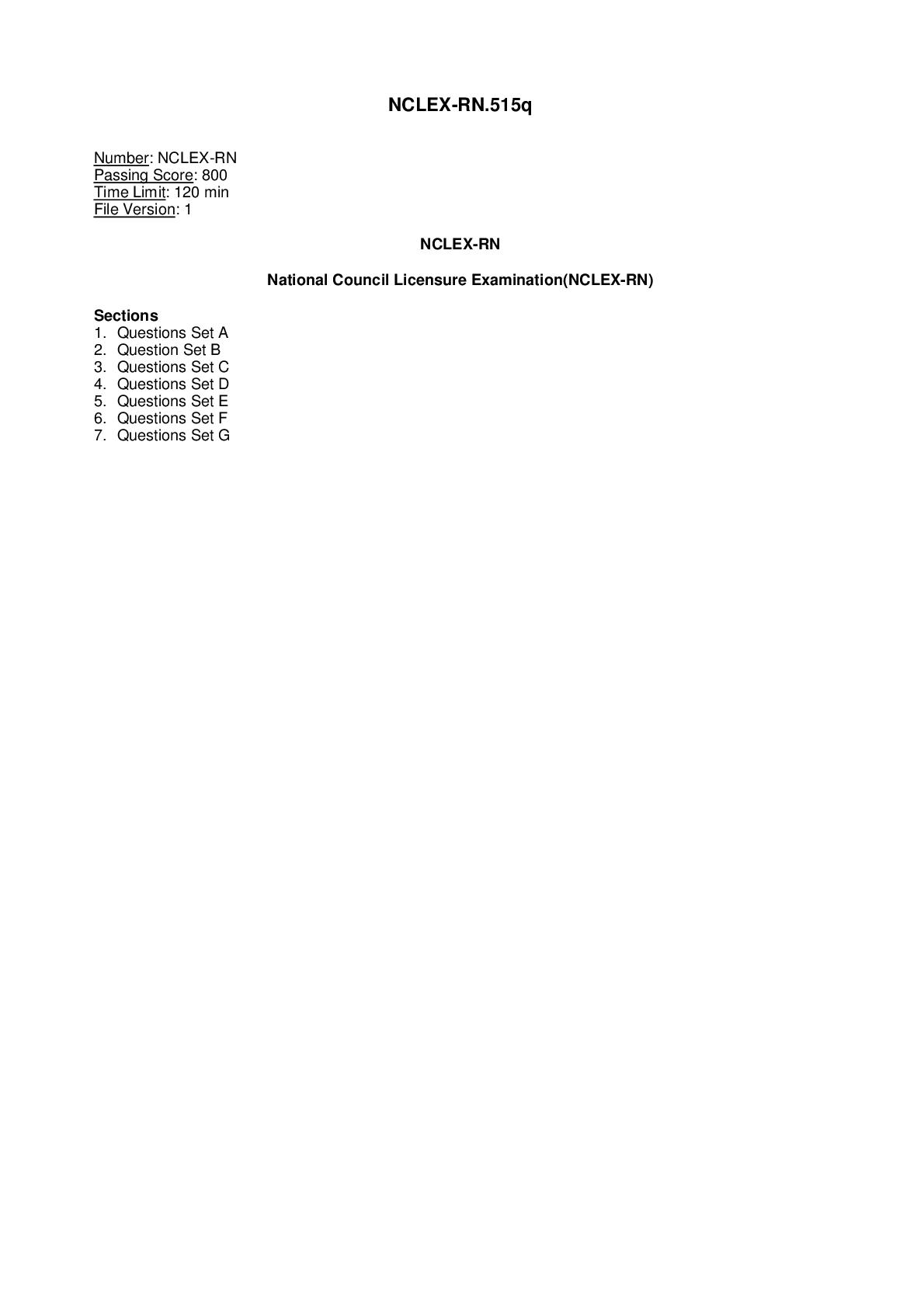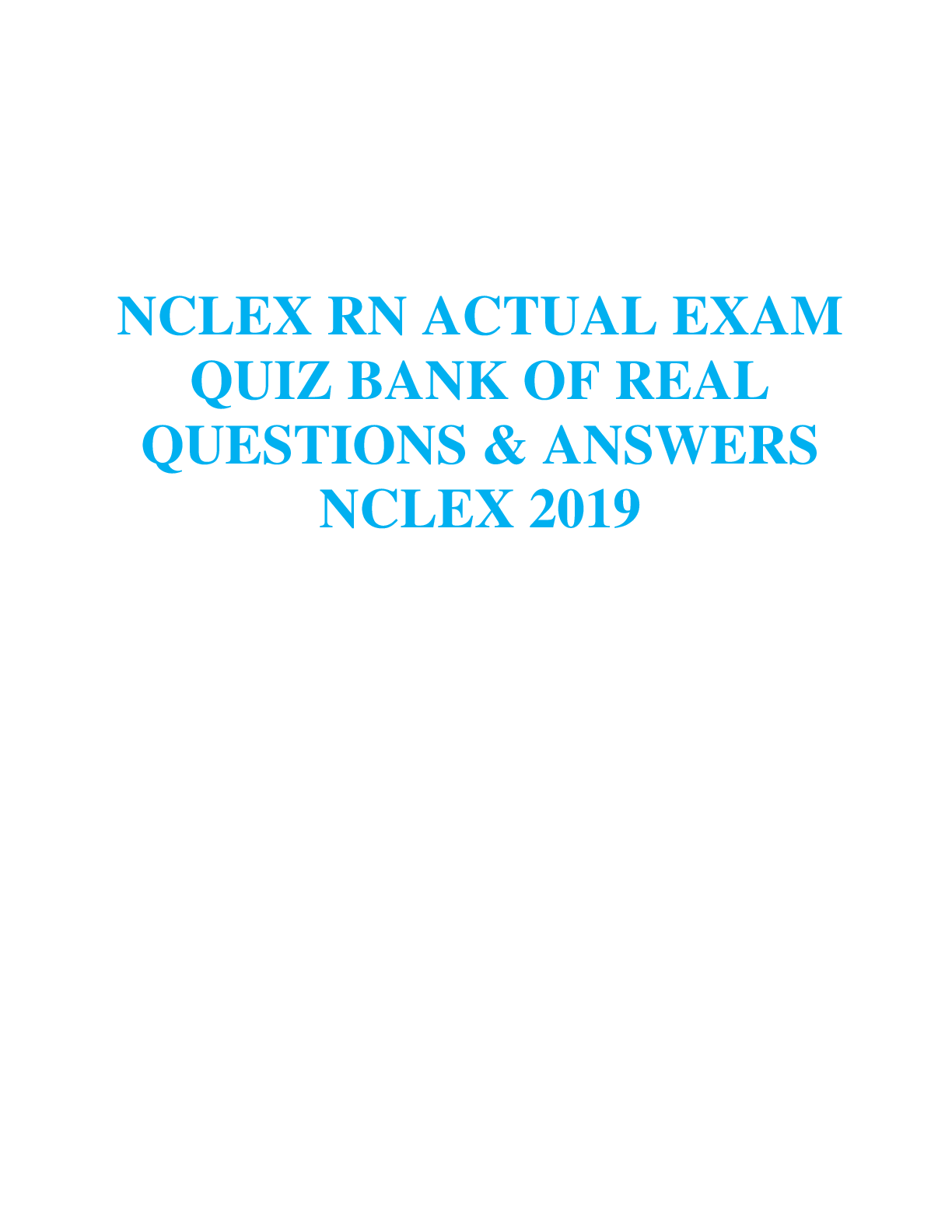NCLEX-RN: NCLEX National Council Licensure Examination (NCLEX-RN)
Document Content and Description Below
Question: 1 On the third postpartum day, the nurse would expect the lochia to be: A. Rubra B. Serosa C. Alba D. Scant Answer: A Explanation: (A) This discharge occurs from delivery through the... 3rd day. There is dark red blood, placental debris, and clots. (B) This discharge occurs from days 4-10. The lochia is brownish, serous, and thin. (C) This discharge occurs from day 10 through the 6thweek. The lochia is yellowish white. (D) This is not a classification of lochia but relates to the amount of discharge. Question: 2 A pregnant client is having a nonstress test (NST). It is noted that the fetal heart beat rises 20 bpm, lasting 20 seconds, every time the fetus moves. The nurse explains that: A. The test is inconclusive and should be repeated B. Further testing is needed C. The test is normal and the fetus is reacting appropriately D. The fetus is distressed Answer: C Explanation: (A) The test results were normal, so there would be no need to repeat to determine results. (B) There are no data to indicate further tests are needed, because the result of the NST was normal. (C) An NST is reported as reactive if there are two to three increases in the fetal heart rate of 15 bpm, lasting at least 15 seconds during a 15-minute period. (D) The NST results were normal, so there was no fetal distress. Question: 3 Which stage of labor lasts from delivery of the baby to delivery of the placenta? A. Second B. Third C. Fourth D. Fifth Answer: B Explanation: (A) This stage is from complete dilatation of the cervix to delivery of the fetus. (B) This is the correct stage for the definition. (C) This stage lasts for about 2 hours after the delivery of the placenta. (D) There is no fifth stage of labor. Question: 4 A client develops complications following a hysterectomy. Blood cultures reveal Pseudomonas aeruginosa. The nurse expects that the physician would order an appropriate antibiotic to treat P. aeruginosa such as: A. Cefoperazone (Cefobid) B. Clindamycin (Cleocin) C. Dicloxacillin (Dycill) D. Erythromycin (Erythrocin)Answer: A Explanation: (A) Cefoperazone is indicated in the treatment of infection withPseudomonas aeruginosa.(B) Clindamycin is not indicated in the treatment of infection withP. aeruginosa.(C) Dicloxacillin is not indicated in the treatment of infection withP. aeruginosa.(D) Erythromycin is not indicated in the treatment of infection withP. aeruginosa. Question: 5 A couple is experiencing difficulties conceiving a baby. The nurse explains basal body temperature (BBT) by instructing the female client to take her temperature: A. Orally in the morning and at bedtime B. Only one time during the day as long as it is always at the same time of day C. Rectally at bedtime D. As soon as she awakens, prior to any activity Answer: D Explanation: (A) Monitoring temperature twice a day predicts the biphasic pattern of ovulation. (B) Prediction of ovulation relies on consistency in taking temperature. (C)Nightly rectal temperatures are more accurate in predicting ovulation. (D) Activity changes the accuracy of basal body temperature and ability to detect the luteinizing hormone surge. Question: 6 A client is having episodes of hyperventilation related to her surgery that is scheduled tomorrow. Appropriate nursing actions to help control hyperventilating include: A. Administering diazepam (Valium) 1015 mg po q4h and q1h prn for hyperventilating episode B. Keeping the temperature in the client’s room at a high level to reduce respiratory stimulation C. Having the client hold her breath or breathe into a paper bag when hyperventilation episodes occur D. Using distraction to help control the client’s hyperventilation episodes Answer: C Explanation: (A) An adult diazepam dosage for treatment of anxiety is 210 mg PO 24 times daily. The order as written would place a client at risk for overdose. (B) A high room temperature could increase hyperventilating episodes by stimulating the respiratory system. (C) Breath holding and breathing into a paper bag may be useful in controlling hyperventilation. Both measures increase CO2 retention. (D) Distraction will not prevent or control hyperventilation caused by anxiety or fear. Question: 7 A client delivered a stillborn male at term. An appropriate action of the nurse would be to: A. State, "You have an angel in heaven." B. Discourage the parents from seeing the baby. C. Provide an opportunity for the parents to see and hold the baby for an undetermined amount of time. D. Reassure the parents that they can have other children. Answer: C Explanation: (A) This is not a supportive statement. There are also no data to indicate the family’s religious beliefs. (B) Seeing their baby assists the parents in the grieving process. This gives them the opportunity to say "good-bye." (C) Parents need time to get to know their baby. (D) This is not a comforting statement when a baby has died. Thereare also no guarantees that the couple will be able to have another child. Question: 8 A 29-year-old client is admitted for a hysterectomy. She has repeatedly told the nurses that she is worried about having this surgery, has not slept well lately, and is afraid that her husband will not find her desirable after the surgery. Shortly into the preoperative teaching, she complains of a tightness in her chest, a feeling of suffocation, lightheadedness, and tingling in her hands. Her respirations are rapid and deep. Assessment reveals that the client is: A. Having a heart attack B. Wanting attention from the nurses C. Suffering from complete upper airway obstruction D. Hyperventilating Answer: D Explanation: (A) Classic symptoms of a heart attack include heaviness or squeezing pain in the chest, pain spreading to the jaw, neck, and arm. Nausea and vomiting, sweating, and shortness of breath may be present. The client does not exhibit these symptoms. (B) Clients suffering from anxiety or fear prior to surgical procedures may develop hyperventilation. This client is not seeking attention. (C) Symptoms of complete airway obstruction include not being able to speak, and no airflow between the nose and mouth. Breath sounds are absent. (D) Tightness in the chest; a feeling of suffocation; lightheadedness; tingling in the hands; and rapid, deep respirations are signs and symptoms of hyperventilation. This is almost always a manifestation of anxiety. Question: 9 A 44-year-old client had an emergency cholecystectomy 3 days ago for a ruptured gallbladder. She complains of severe abdominal pain. Assessment reveals abdominal rigidity and distention, increased temperature, and tachycardia. Diagnostic testing reveals an elevated WBC count. The nurse suspects that the client has developed: A. Gastritis B. Evisceration C. Peritonitis D. Pulmonary embolism Answer: C Explanation: (A) Assessment findings for gastritis would reveal anorexia, nausea and vomiting, epigastric fullness and tenderness, and discomfort. (B) Evisceration is the extrusion of abdominal viscera as a result of trauma or sutures failing in a surgical incision. (C) Peritonitis, inflammation of the peritoneum, can occur when an abdominal organ, such as the gallbladder, perforates and leaks blood and fluid into the abdominal cavity. This causes infection and irritation. (D) Assessment findings of pulmonary embolism would reveal severe substernal chest pain, tachycardia, tachypnea, shortness of breath, anxiety or panic, and wheezing and coughing often accompanied by blood-tinged sputum. [Show More]
Last updated: 1 year ago
Preview 1 out of 541 pages

Reviews( 0 )
Document information
Connected school, study & course
About the document
Uploaded On
Jun 18, 2022
Number of pages
541
Written in
Additional information
This document has been written for:
Uploaded
Jun 18, 2022
Downloads
0
Views
88



 UPDATED ON MARCH 19, 2022, BSN, R.png)



